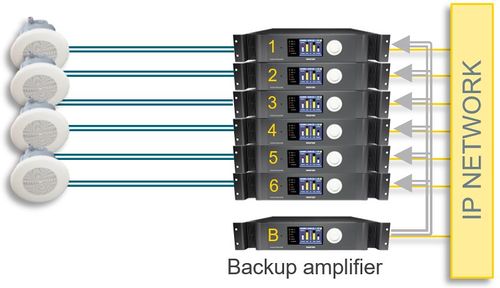Difference between revisions of "Backup Amplifier"
(→Functional description) |
|||
| Line 13: | Line 13: | ||
| − | |||
| − | + | Faults such as power faults, faults affecting the internal amplifier module and loss of network connection will trigger the backup functionality. | |
| − | |||
| − | |||
Revision as of 13:18, 7 July 2016
This article describe how the backup functionality work.
Exigo ENA Amplifiers have inbuilt support for backup amplifier switchover where one amplifier can be designated as backup for up to six other amplifiers.
If there is a problem in one of these amplifiers the backup amplifier will take over the configuration and output stage of the defect amplifier and continue with distributing audio out on the speaker loops.
Exigo ENA Amplifiers offer up to 6+1 backup functionality.
Contents
Functional description
- When the backup amplifier functionality is activated the backup amplifier monitors the amplifier(s) it is backup for.
- If one of the amplifiers fails, it will take over the outputs and start sending the same audio as the failing amplifier.
- Both speaker loops of the defect amplifier will be taken over by the backup amplifier.
- Speaker monitoring will be suspended when the amplifier is taken over.
Faults such as power faults, faults affecting the internal amplifier module and loss of network connection will trigger the backup functionality.
Figure 1 shows an example on how one backup amplifier takes over the output stage off one of the two amplifiers it is backup for. The output stages in the defect amplifier will be remote controlled from the backup amplifier which will work even if the defect amplifier have lost all power.
The backup amplifier will be monitoring the amplifiers it is backup for and decide when to activate the backup functionality. Faults such as power faults, faults affecting the internal amplifier module and loss of network connection will trigger the backup functionality.
In addition, an optional function on a control input on the backup amplifier can trigger the backup functionality. This will ensure an even faster switchover if the defect amplifier has network or power issues.
In situations where more than one amplifier is defect the backup amplifier will take over for the first defect amplifier unless priorities are activated. With this functionality activated the backup amplifier will take over for the defect amplifier with the highest priority and, if already activated, release defect amplifiers with lower priority.
Configuration
See Backup_amplifier_configuration for details on how to configure the backup amplifier functionality.
Connections
See Backup_amplifier_wiring for details on how to wire the system to use backup amplifier functionality.
Control inputs and control outputs
Spare control inputs or control outputs on the backup amplifier can be used for other functions in the Exigo system, such as volume controls and starting activities.
On the normal amplifiers, control inputs and control outputs not used for backup functionality can be used for other functions. These will work as normal as long as the amplifier have power and network connection.
Resetting the amplifier functionality
After fixing the defect amplifier human intervention is required to reset the backup amplifier functionality. This is done by accessing the user interface in front of the backup amplifier. After the reset the backup amplifier will be back in standby and be ready to take over other defect amplifiers.
